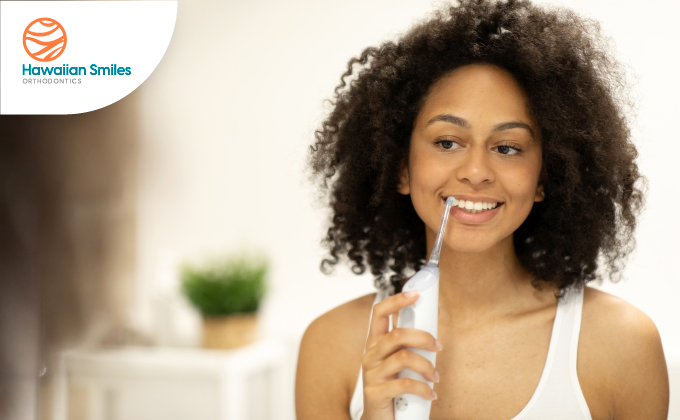
Is a Waterpik Better Than Flossing?

In case you have yet to be warned about the importance of good oral hygiene habits, this article explains why you should take proper care of your teeth and how to clean your mouth, especially when you are an orthodontic patient.
Do not believe weird myths from TikTok; only follow your dentist’s or orthodontist’s recommendations. Your doctor is the one qualified to indicate how to brush and floss your teeth properly. And if you wear an orthodontic appliance like clear aligners or conventional braces, you should ask your doctor for the best way to do it.
Many people believe they cannot floss their teeth if they wear metal braces, which is not true. In fact, it’s crucial for your dental health that you floss during your orthodontic treatment.
Braces can add a little difficulty to the cleaning process since you have in your mouth a considerable number of appliances you do not normally have. This means the cleaning process must be thorough to get rid of any food particles resting on your teeth.
Therefore, you should include flossing in your dental hygiene routine. It can be hard to floss the traditional way, but there are also dozens of new tools designed to make your work easier and more efficient.
Self-threading flossers and Waterpik tools are two of many great solutions to this issue.
How to Practice Good Oral Hygiene?
The basics of dental hygiene are persistence and fluoride. Regular brushing is an essential step to a healthy mouth. What toothpaste and technique you use when washing your teeth is also key. Dental experts recommend using dental products with xylitol or fluoride.
These are ingredients with a great track record regarding dental health. They help to eliminate biofilm or bacteria from your mouth to avoid tooth decay, cavities, and gum disease. But brushing your teeth is a must from age 2 (and even younger!).
Dental floss and mouthwash are other beneficial and needed steps. Traditional flossing will allow you to reach the spots in between your teeth and prevent plaque. No toothbrush can reach these difficult parts as dental floss can.
Mouthwash will contribute to refreshing your breath, and depending on your product of choice, you can also fight bacteria and whiten your teeth.
Whether you are a patient with orthodontic appliances or not, other fantastic tools can optimize your hygiene routine.
- Water flosser.
- Electric toothbrush.
- Floss threaders or cordless flossers.
- Interdental brushes.
How to Use a Water Flosser?
Even though oral irrigators have become popular and common in many homes, a significant percentage of people are not familiar with them. Many know water flossers better by the name of Waterpik, a famous brand. So, how to use one at home?
Since oral irrigators are designed for you to use at home, they are very easy and intuitive. You just have to fill the water reservoir. The water’s temperature depends on you, but try to avoid extremes. Lukewarm water is the best. Turn your device on when you are ready to use it (before or after brushing).
Put the tip inside your mouth and direct the water stream to your gums, the spaces in between your teeth, and the back and front of each tooth. The water comes out with pressure enough to swipe food particles without hurting your gums.
Clean the tip and water tank of your dental water jet regularly to prevent bacteria from growing.
Are Water Dental Flossers as Effective and Safe as Dental Floss?
It’s a mistake to say water flossing can replace regular dental flossing or brushing. They are different and have different purposes. The oral irrigator can reach places in a way no other tool can, just as dental floss allows a deeper cleaning than a toothbrush.
To the question about their safety, the answer is they are super safe because it’s just water with a little pressure. If you notice any discomfort while using a water flosser, check everything is in the right place and that you are following instructions correctly. If the issue persists, talk to your doctor.
A dental water flosser supports the efforts made with common dental floss. If you do not like traditional floss or find it too hard, you can try cordless models like self-threading flossers that can be found at supermarkets or pharmacies, and you can also try interdental brushes -these are a wonderful option for people with dental braces.
How to Clean a Water Flosser?
Cleaning your Waterpik is easy. The first rule is always to leave its water container empty and dry after you use it. If you practice regular flossing, we recommend washing it more thoroughly with dish soap and water.
It’s very important to keep the tip clean. With some water flossers, you can disassemble each part to clean them individually. Keep the tip in a clean and dry space and remove excess water after use.
At a supermarket, you can find a thin brush to clean the inside of your dental irrigator tip, like the ones designed to clean non-disposable straws.
Your Dentist in Kaneohe
Do not leave your oral health unattended, and schedule an appointment at our dental practice. We are located in Kaneohe, Hawaii. Bring your doubts about dental hygiene, oral care, and orthodontic appliances to us!



